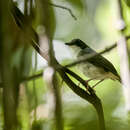Biology
provided by Arkive
The solitary and secretive little slaty flycatcher spends much of its time hidden amongst dense foliage, and its presence is only detected by its characteristic call (2). It searches in low vegetation in the forest for small invertebrates to eat, and only emerges onto an exposed perch when excited or agitated (2).
Information is scarce regarding breeding in this species, but little slaty flycatchers were found in a breeding condition in May and June (2). Only one nest has ever been found; a frail structure, made of roots and lined with leaves, well concealed in forest litter near the ground. Within this nest were two eggs (2) (5).
Conservation
provided by Arkive
The presence of this vulnerable bird in Mount Apo and Mount Malindang National Parks may afford the little slaty flycatcher some protection (2), but it would greatly benefit from the protection of five further important sites (5). Clarifying its current distribution and population status in the remaining fragments of lowland forest is another proposed measure (5).
Description
provided by Arkive
This secretive bird belongs to the flycatcher family, a group named for their propensity to make short sallies from a perch to catch flying insects in their bill (3). The little slaty flycatcher has a short tail and a heavy bill surrounded with bristles (2) (3). The male has a slaty-grey head and upperparts, brownish flight feathers, white underparts and a grey wash on the breast and flanks. Females have a rufous-brown head and upperparts, and white underparts washed with rufous on the breast and flanks. The sexes also differ by the fairly prominent whitish spot on the side of the neck of the male (2). Both have dark brown irises, a black bill and pale pink to pinkish-grey legs (2). The little slaty flycatcher skulks in dense vegetation, so it is more easily located by its high pitched three-note call, or its beautiful, warbling song (4).
Habitat
provided by Arkive
Inhabits the tangled understorey of primary forest and secondary forest, including selectively logged forest, up to elevations of 1,200 meters (2)
Range
provided by Arkive
The little slaty flycatcher is endemic to the Philippines. There are two subspecies; F.b. basilanica occurs on the islands of Dinagat, Mindanao and Basilan, whilst F. b. samarensis is found only on Samar and Leyte (2)
Status
provided by Arkive
Classified as Vulnerable (VU) on the IUCN Red List 2007 (1).
Threats
provided by Arkive
The little slaty flycatcher is threatened by the widespread destruction of its forest habitat. The clearance of lowland forest for agriculture, logging, golf courses, and mining in the Philippines, has resulted in the little slaty flycatcher population declining rapidly (2) (5).
Little slaty flycatcher
provided by wikipedia EN
The little slaty flycatcher (Ficedula basilanica) is a species of bird in the family Muscicapidae. It is found on the islands of Mindanao, Leyte and Samar in the Philippines.
Its natural habitat is tropical moist lowland forests. It is threatened by habitat loss.
Description
EBird describes the bird as "A small bird of tangled undergrowth in lowland and foothill forest. White below with pale orange legs. Male has dark gray upperparts and a short white stripe behind each eye. Upperparts are dark brown in female with no head stripes. Female similar to Chestnut-tailed Jungle Flycatcher, but has orange legs and a dark brown rather than chestnut tail. Song consists of short, varied whistled notes, often in a rising or falling series. Also gives single thin high downslurred whistles."[2]
They are sexually dimorphic in which males have the eponymous slaty-grey color with the females being light brown. [3]
Habitat and conservation status
Its natural habitats at tropical moist lowland primary forest and well developed secondary forest up to 1,200 meters above sea level. It is often seen close to the forest floor staying in the low understory.
IUCN has assessed this bird as vulnerable with the population being estimated at 2,500 to 9,999 mature individuals. Extensive lowland deforestation on all islands in its range is the main threat. Most remaining lowland forest that is not afforded protection leaving it vulnerable to both legal and Illegal logging, conversion into farmlands through Slash-and-burn and mining.
It occurs in the protected areas of Pasonanca Natural Park, Mount Apo National Park and Mt. Hilong-hilon National Park but enforcement and protection from loggers are lax.
References

- license
- cc-by-sa-3.0
- copyright
- Wikipedia authors and editors
Little slaty flycatcher: Brief Summary
provided by wikipedia EN
The little slaty flycatcher (Ficedula basilanica) is a species of bird in the family Muscicapidae. It is found on the islands of Mindanao, Leyte and Samar in the Philippines.
Its natural habitat is tropical moist lowland forests. It is threatened by habitat loss.
- license
- cc-by-sa-3.0
- copyright
- Wikipedia authors and editors

